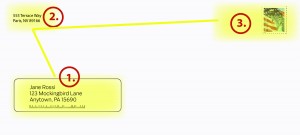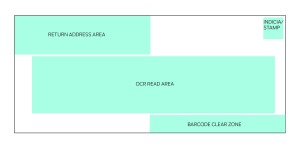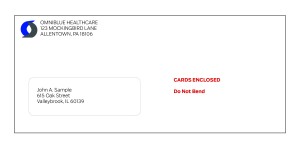Direct Mail: Getting That Envelope Opened
by admin Direct mail can be very effective, when done right. And despite the popularity of digital strategies, marketers have discovered that a multi-channel approach, using both direct and digital marketing, works best. In fact, direct mail has seen a resurgence over the last few years. According to an International Communications Research study, 73% of consumers actually prefer direct mail over other forms of advertising1. Unlike email messages, which can easily escalate into the hundreds each day, consumers get relatively few pieces of physical mail in their mailboxes, which means less competition for you. But before your direct mail can be truly effective, you must get the recipient to open your envelope. Only then can they respond to your call-to-action and boost your ROI.
In the 1970s, Professor Siegfried Vogele, the then Dean of the Institute for Direct Marketing in Munich, West Germany, performed eye movement studies. He not only studied the eye movement on direct mail letters, but on the envelopes as well. He learned that mail recipients only spend about 8 seconds scanning the envelope before they decide whether or not to open it. Even more interesting is that most of that time is spent looking at the back of the envelope – while it is being opened!
Professor Vogele noted that mail recipients first look at the name & mailing address, then the return address and finally glance over to the upper right hand corner to the area of the stamp or indicia. Taking this information into consideration, you’ll definitely want to concentrate on those three areas when planning your next mailing.

Tips for Getting Your Direct Mail Opened
Type of envelope. Here at CPS Cards, we like to encourage our customers to use a #10 window envelope. A plain white window envelope communicates to the recipient that whatever is inside is of a business nature. Also, if you are using a plastic card as part of your direct mail piece, letting that card slightly peek through the window adds intrinsic value and prompts the prospect to open it. Consumers are very hip these days and know that a faux “Express” envelope is not really from FedEx or UPS, so save yourself some money and skip that marketing tactic.
The human touch. Although many direct mail printers offer the option of sending a “handwritten” envelope (which is actually a person’s handwriting that has been transformed into a printed font), many consumers are wise to this “trick,” even though some of these applications are very convincing. If you don’t want your envelope to look like it is a part of a one thousand piece mailing, consider using a First Class stamp in lieu of an indicia. A stamp requires human touch, therefore, the recipient is more likely to believe that your direct mail piece is personal, not just part of a large mailing.
The return address. If Professor Vogele was right in his studies, and the return address is the second area a recipient looks towards, then some thought should be put into this before proceeding with your mailing. Why do you think they look towards that area? Because they want to know… who is sending the correspondence? If they have already received previous mail from this same company? If the sender is a legitimate company? Ultimately, the information found in the return address area will help them make a determination on whether or not to open the envelope. For this reason, don’t use a P.O. box – use a street address instead. This adds credibility and value, and will help with lift. Also, you might consider NOT using your company name or logo, instead, let mystery and/or fear drive them to open it. They wouldn’t want to throw something valuable away, after all.
Teaser copy. There are many arguments for and against adding teaser copy to an envelope. Adding a teaser can create excitement or generate curiosity, however you don’t want to mislead the recipient. Adding deceptive copy will only infuriate the prospect once they open the envelope and find out it was nothing that they thought it was. Transparency is key in building relationships, so don’t begin one with a fib. Also, be careful of where you place your teasers. Refer to the USPS guidelines to stay clear of any “off limits” areas of the envelope, such as the barcode clear zone. And don’t forget that you have two sides to an envelope. Since most people spend the majority of the time looking at the back of the envelope, a teaser there helps to re-emphasize your message or boost brand image.

Change it Up. If you are planning on sending out multiple mailings over the course of time, consider changing up the look of the envelope, the teaser, or even the return address. If a prospect sees the same envelope over and over, the mystery of what is inside, isn’t a mystery anymore, and in the trash it will go.
These are just a few of the ways that you can help improve envelope open rates. You can experiment with envelope color and size, include a three dimensional object or card, or, if your budget allows, consider sending your correspondence in unique packaging. The key to knowing what will or won’t work is to think about which envelopes YOU would open. After all, you are someone’s prospect too!
1 http://www.marketingprofs.com/articles/2014/24084/print-marketing-will-thrive-in-2014-and-beyond
Can CPS Cards help with your direct mail program? Contact us or call 888.817.8121 to request a free quote.


